Highlights Test campaigns, media segments, and any of your campaigns using new A/B tests Previously, when testing campaigns, we had to rely on additional help from workflows, static segments, export actions, and Excel calculations. Built-in A/B tests tests are now available in Maestra. To do this, in the “Campaigns” section: create an A/B test and […]
Decathlon Launched a Loyalty Program in 62 Stores and Identified 44% Of Offline Purchases in Three Months
Challenges
Create a single marketing center for managing online communications with customers in all channels
Launch an omnichannel loyalty program
Launch an omnichannel loyalty program
Solutions
Create a single-window interface unifying email communications, web push notifications, SMS, email, and website recommendations, and then the loyalty program
Test the loyalty program in retail stores, and then launch the omnichannel loyalty program
Test the loyalty program in retail stores, and then launch the omnichannel loyalty program
Results
The share of identified offline customers increased from 11% to 44%
The average share of email revenue in the total revenue of the online store is now 4,7%
The average share of email revenue in the total revenue of the online store is now 4,7%
Integrated with:
Online store and mobile app, Set Retail cash registers
Noteworthy features
The team collects feedback via emails. This helps Decathlon understand which products are no longer popular and should not be restocked and which products should be improved.
Decathlon has automated emails and launched a retail loyalty program. As this big project has been implemented, we can confidently say that now the company:
- Takes into account the interests of its audience across its communications. For example, we discovered that segmenting customers based on whether they are soccer fans makes no sense. However, when we segment them according to their love of horseback riding, we see a profitable result (each sent email brings $0.20 in revenue).
- Makes decisions regarding the purchase of goods overseas and adapts its own production based on feedback submitted by customers via emails. For instance, last winter we received bad reviews about snow tubes (inflatable sleds). As a result, in the summer, we improved their production and now we have released better-quality snow tubes.
- Has tested the frequency of bulk campaigns using A/B tests, which has not only stopped customers from getting spammed, but also ensured revenue won’t be lost from the email channel. We now send out two emails on a weekly basis: one with general offers for the entire audience, the second with personalized offers depending on the customer segment.
- Knows its offline customers. We noticed something rather interesting: our most loyal customers tend to shop in stores that are located far away from other sports stores or shopping centers. This segment has the highest level of customer identification.
Our main task was to launch an omnichannel loyalty program in a short period of time with minimal effort and investment. Maestra really helped us with this mission. We are delighted with the project and the results.
The results of the loyalty program. We implemented the platform in two months, which included setting up the loyalty program, and a data exchange between the POS and the platform. We then carried out tests across five months and five stores. We launched the loyalty program in 62 stores in only two months.
We have been getting only positive feedback both from the stores and our customers. The share of identified offline customers has increased from 11% to 44%. By the end of 2022, we plan to reach 50%. This is a great result! We achieved it pretty quickly as well
Marketing Automation Results
-
11
% → 44% share of identified customers offline -
4.7
% average share of revenue from email campaigns relative to the online store’s total revenue (November 2020 — April 2022) -
$ 0.20RPE (Revenue per email) from a customer segment interested in horseback riding -
$ 0.0086 –$ 0.013average RPE from bulk campaigns across all segments
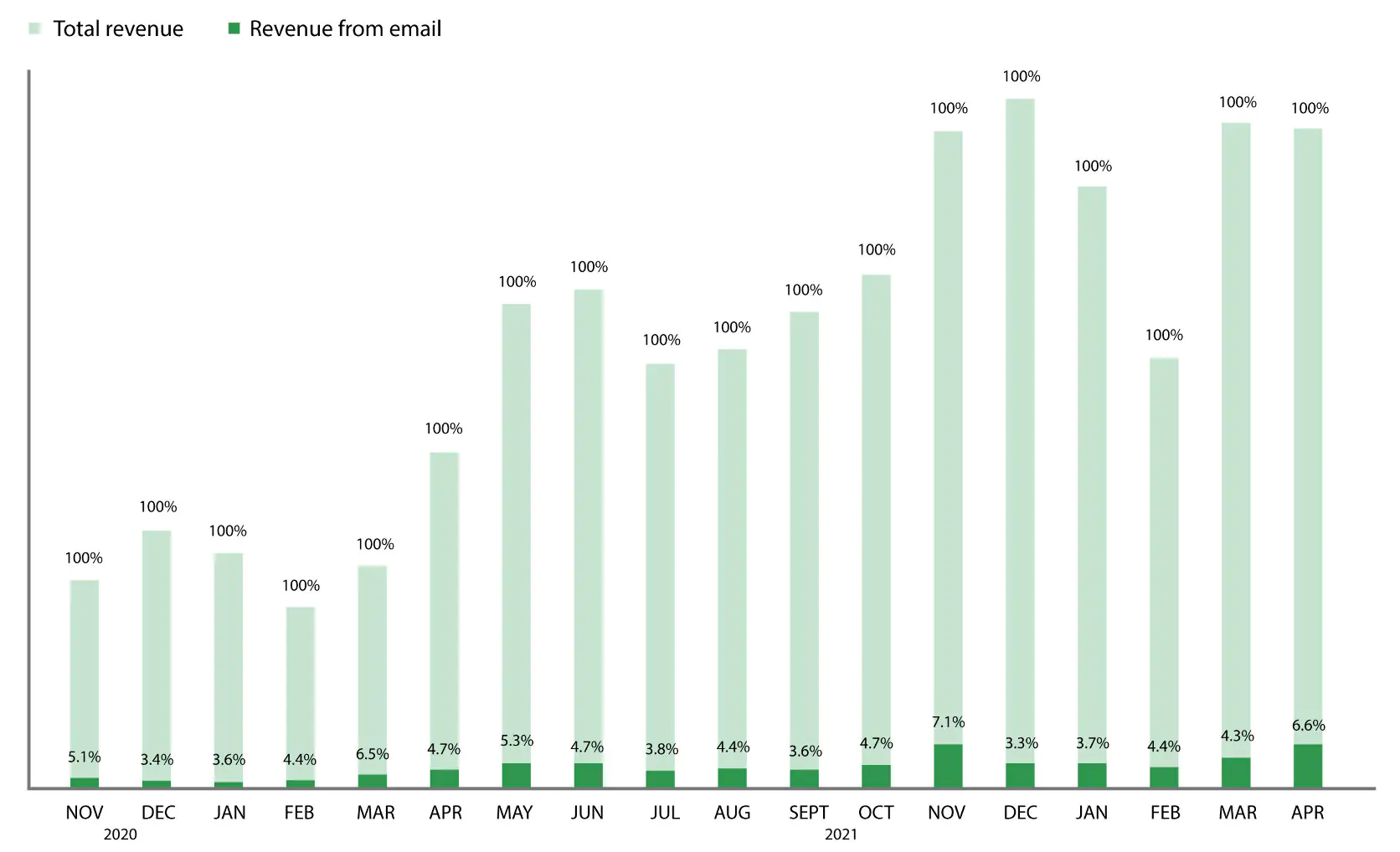
Data on the share of email revenue from Maestra’s Communications Dashboard, and on the total revenue from the Turnover and Repeat Orders report. The rest of the data is from Decathlon’s internal reporting in Google Analytics. Data based on Last Click Attribution.
We consider the current revenue share of the email channel a good result. It wouldn’t be right to compare us with FMCG retailers or cosmetics stores (where the share of revenue from emails is 15-20% on average) due to the fact that we have a large customer base, each of whom make around 1.5 purchases a year on average
How marketing has changed after implementing the platform
Overall impression of the platform. One of Maestra’s main advantages is that we are able to operate quickly and effectively with the system. The Maestra team is able to help us swiftly with any problems we may have. The platform’s flexibility allows us to finish up almost all of our business tasks. There is no campaign that we can’t launch because Maestra doesn’t have the features needed.
We have an excellent manager — Anya Stepanova. She helps at any time whether day or night, in any communication channel. It’s really great to work with Anya as she is highly professional and overall a kind person who is always ready to help.
I am really pleased that in 2020 we made the decision to launch a loyalty program with Maestra. I am 99% sure that if we had chosen another company or, for example, a server solution instead of a cloud solution, we would have experienced many more complications, expenses, and difficulties. The way we worked with Maestra was much easier than the classic loyalty program implementation projects I’ve worked on elsewhere.
How we chose the platform. The platform was chosen by our CEO, Chief Digital Officer, loyalty program team, technical department, and the marketing department.
Our main requirement was the ability to unify a loyalty program, email, and recommendations in one interface. We spoke to many companies and we realized that Maestra is the only candidate that meets our requirements in terms of features and cost expectations.
We anticipated that by switching from the previous CDP to Maestra, we would set up the same communications, and we would see an increase in income. As Ma will improve the delivery of emails, we will be able to send them on time due to the high sending speed.
In reality, in the first months after the transition, we saw a drop in revenue. I believe this happened as a result of an incorrectly imported database. However, this issue was soon resolved.
In just six months, we managed to reach the metrics we were looking for and stabilize them.
The transition to the platform took three months: we signed a contract, and the platform was integrated with the website.
Integration with the online store and the app is not yet complete, so the platform isn’t working at 100% capacity right now. For example, not all transactions are tracked in real-time (they are imported into the platform at a later date), we don’t track customer transactions through the app, and we don’t send mobile push notifications. This happened as a result of not investing in the full integration of the previous platform as we were already developing a new online store at the time the platform was connected.
What has changed
Before Maestra was implemented
After Maestra was implemented
Loyalty Program
In 2018, the loyalty program was disconnected and the share of identified offline customers fell from 30% to 11%.
Due to this, it was almost impossible to understand what kind of customers were making purchases in retail stores and how to communicate with them in order to motivate them to make repeat purchases.
Due to this, it was almost impossible to understand what kind of customers were making purchases in retail stores and how to communicate with them in order to motivate them to make repeat purchases.
The share of identified offline customers comes out at 44%. This is the share of receipts that were linked to specific customers during three months of the loyalty program, which took place in stores across the country.
This allows us to send campaigns and messages to our offline customers and motivate them to make a repeat purchase.
This allows us to send campaigns and messages to our offline customers and motivate them to make a repeat purchase.
Communication channels
We communicated with customers only via email.
We didn’t send web push notifications, because in the previous CDP system we were using as this cost the same as sending emails. This proved unprofitable for Decathlon because web push notifications usually generate less revenue than emails.
We didn’t send web push notifications, because in the previous CDP system we were using as this cost the same as sending emails. This proved unprofitable for Decathlon because web push notifications usually generate less revenue than emails.
Decathlon communicates with customers via email, web push notifications, and SMS. We believe that the cost of launching push notifications is justified and pays off.
Segmentation and triggered communications
The previous system was not always able to cope with segments based on multiple parameters (sport, history of interactions with emails) and this often resulted in technical errors.
If it was still possible to build a segment, then it couldn’t be saved for future campaigns.
Due to this, it was difficult to set up triggered emails. They were sent only to new customers.
If it was still possible to build a segment, then it couldn’t be saved for future campaigns.
Due to this, it was difficult to set up triggered emails. They were sent only to new customers.
The platform allows Decathlon to configure each segment according to several parameters, save it, and use it for future campaigns.
We now send the following triggered campaigns: welcome chain, abandoned cart, abandoned item and category view, and item back in stock, as well as post-purchase communications that motivate customers to purchase related products.
We now send the following triggered campaigns: welcome chain, abandoned cart, abandoned item and category view, and item back in stock, as well as post-purchase communications that motivate customers to purchase related products.
A/B testing
The previous system sent emails at a very slow pace of 500,000 emails per hour. This speed was not sufficient for a database of two million customers. We weren’t able to come to any reliable conclusions regarding test results.
For example, we tested the subject of the email. The first version of the email took from 13 to 15 hours to be sent and the second version — from 15 to 17 hours. As a result, it turned out that it was not the subject of the email that was being tested, but the sending time.
For example, we tested the subject of the email. The first version of the email took from 13 to 15 hours to be sent and the second version — from 15 to 17 hours. As a result, it turned out that it was not the subject of the email that was being tested, but the sending time.
The platform allows Decathlon to choose any sending speed, from 500 to 2,000,000 emails per hour.
This creates the opportunity to test any parameter: subject, offer, frequency, or sending time — and get reliable results.
This creates the opportunity to test any parameter: subject, offer, frequency, or sending time — and get reliable results.
Launching pop-up notifications and embedded blocks
We brought in developers as part of the launch. For example, a pop-up notification with a survey on why customers are leaving the website took a week to set up.
Marketers create pop-up notifications themselves in just 2 minutes.
Technical issues
In the previous CDP system, synchronizing the customer database with the website took place once a day. Technical failures occurred quite often. Decathlon marketers didn’t receive any notifications and were unaware of these errors.
A living illustration of such an error is the failure to import new customers into the system. As a result, these customers didn’t receive abandoned cart mailings, which might have motivated them to make a purchase. The marketers only found out about the failure by accident.
A living illustration of such an error is the failure to import new customers into the system. As a result, these customers didn’t receive abandoned cart mailings, which might have motivated them to make a purchase. The marketers only found out about the failure by accident.
The synchronization of orders and customers between the automation platform and the website takes place in real-time.
For added security, additional synchronization takes place once a day. This involves the bulk import of customers in case some data belonging to a particular customer or data regarding several customers wasn’t properly uploaded / stored in the database.
In case of a technical failure, marketers immediately receive a notification.
For added security, additional synchronization takes place once a day. This involves the bulk import of customers in case some data belonging to a particular customer or data regarding several customers wasn’t properly uploaded / stored in the database.
In case of a technical failure, marketers immediately receive a notification.
How campaigns help manage purchases and improve production quality
The audience’s interests are a priority.
Decathlon gets few repeat purchases, which means it has to judge customers according to one or two purchases at most. As a result, Decathlon had to segment customers based on their interest in various sports. However, this was no easy task either.
When I came to Decathlon, I thought that customers who bought boots would receive emails about boots and soccer and would become regular customers who make repeat purchases.
However, it doesn’t really work like this. There are segments of interest in a particular sport that don’t require mailings. For example, those who buy goods for fitness, basketball, and football. These customers don’t play sports, they go to the gym a couple of times with friends, they buy a ball to play with when they go on holiday, and they almost always purchase boots for their children.
Therefore, quite a large part of the emails are received by customers who don’t make further purchases as they don’t exercise regularly.
Despite this, we are constantly looking for new segments. For example, there are narrow segments that actively open emails, visit the website, and make repeat purchases. These are people who do sports on a regular basis: rock climbing, horseback riding, swimming (children’s segment), hunting, and fishing.
However, it doesn’t really work like this. There are segments of interest in a particular sport that don’t require mailings. For example, those who buy goods for fitness, basketball, and football. These customers don’t play sports, they go to the gym a couple of times with friends, they buy a ball to play with when they go on holiday, and they almost always purchase boots for their children.
Therefore, quite a large part of the emails are received by customers who don’t make further purchases as they don’t exercise regularly.
Despite this, we are constantly looking for new segments. For example, there are narrow segments that actively open emails, visit the website, and make repeat purchases. These are people who do sports on a regular basis: rock climbing, horseback riding, swimming (children’s segment), hunting, and fishing.
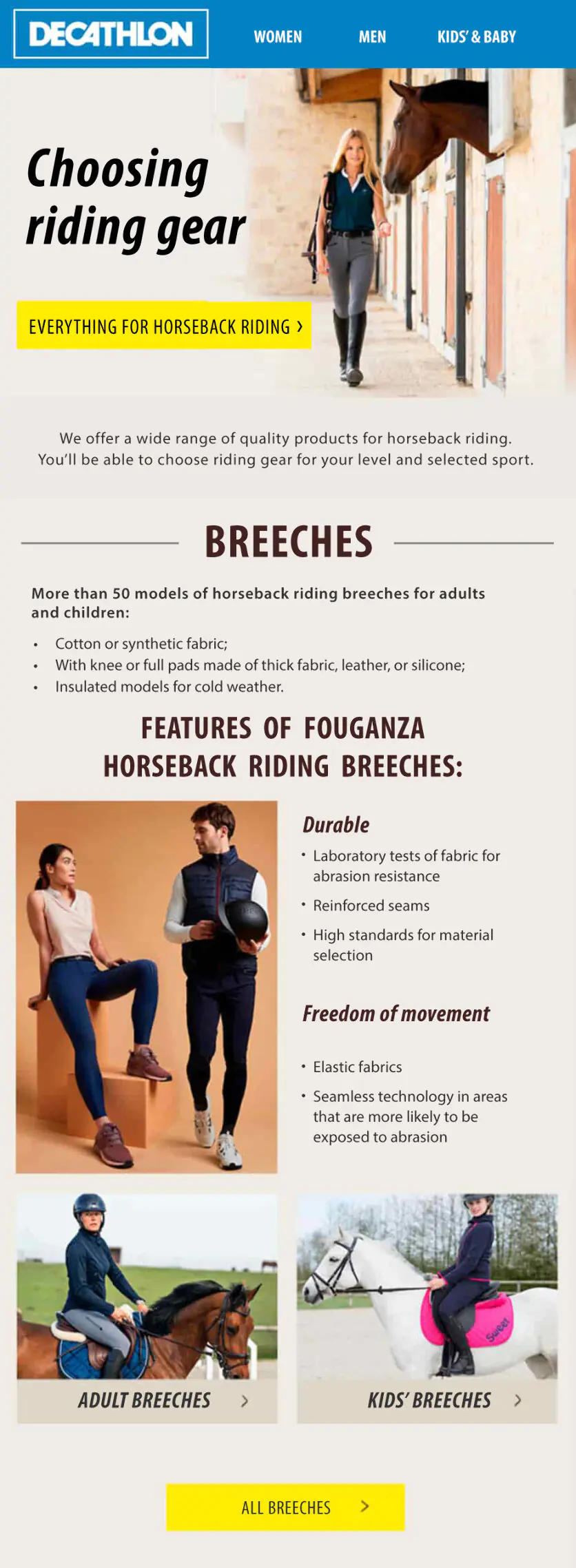
An email for the segment of the audience interested in horseback riding
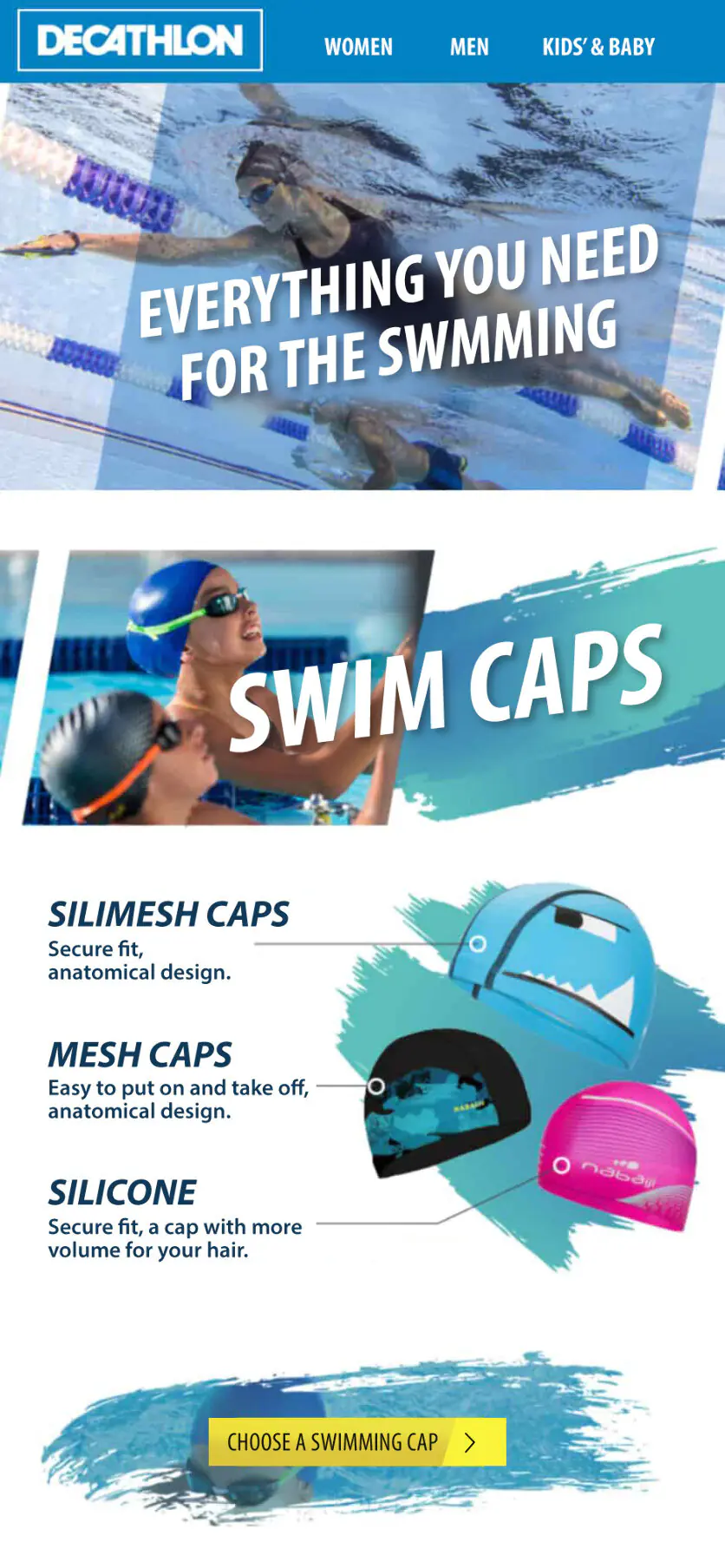
An email for the segment of the audience interested in swimming
Getting feedback in emails to manage restocking and improve products
Emails help us collect customer feedback regarding specific products and the quality of service in stores. The email is sent three weeks after the purchase, which gives the customer time to test the product.
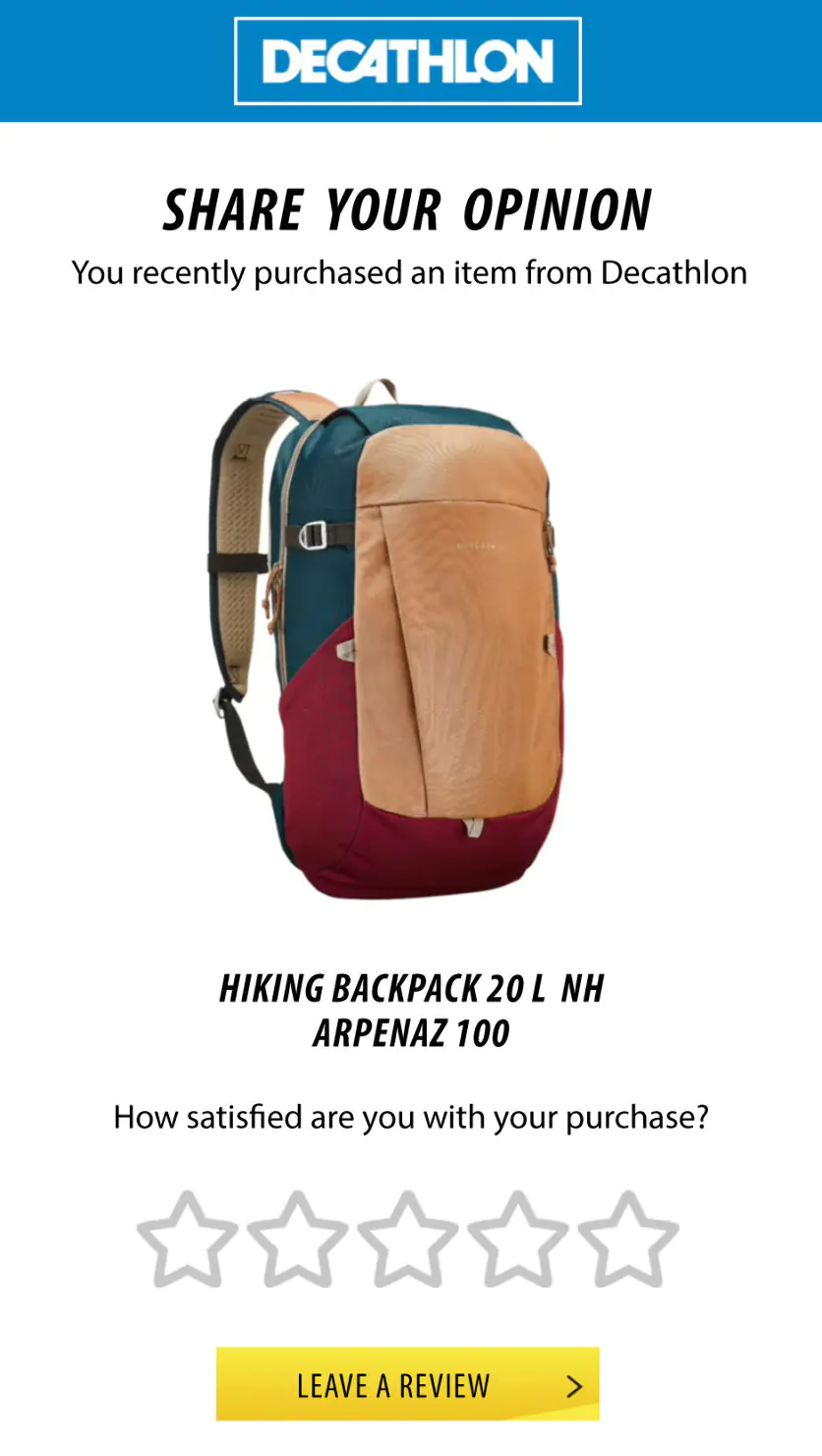
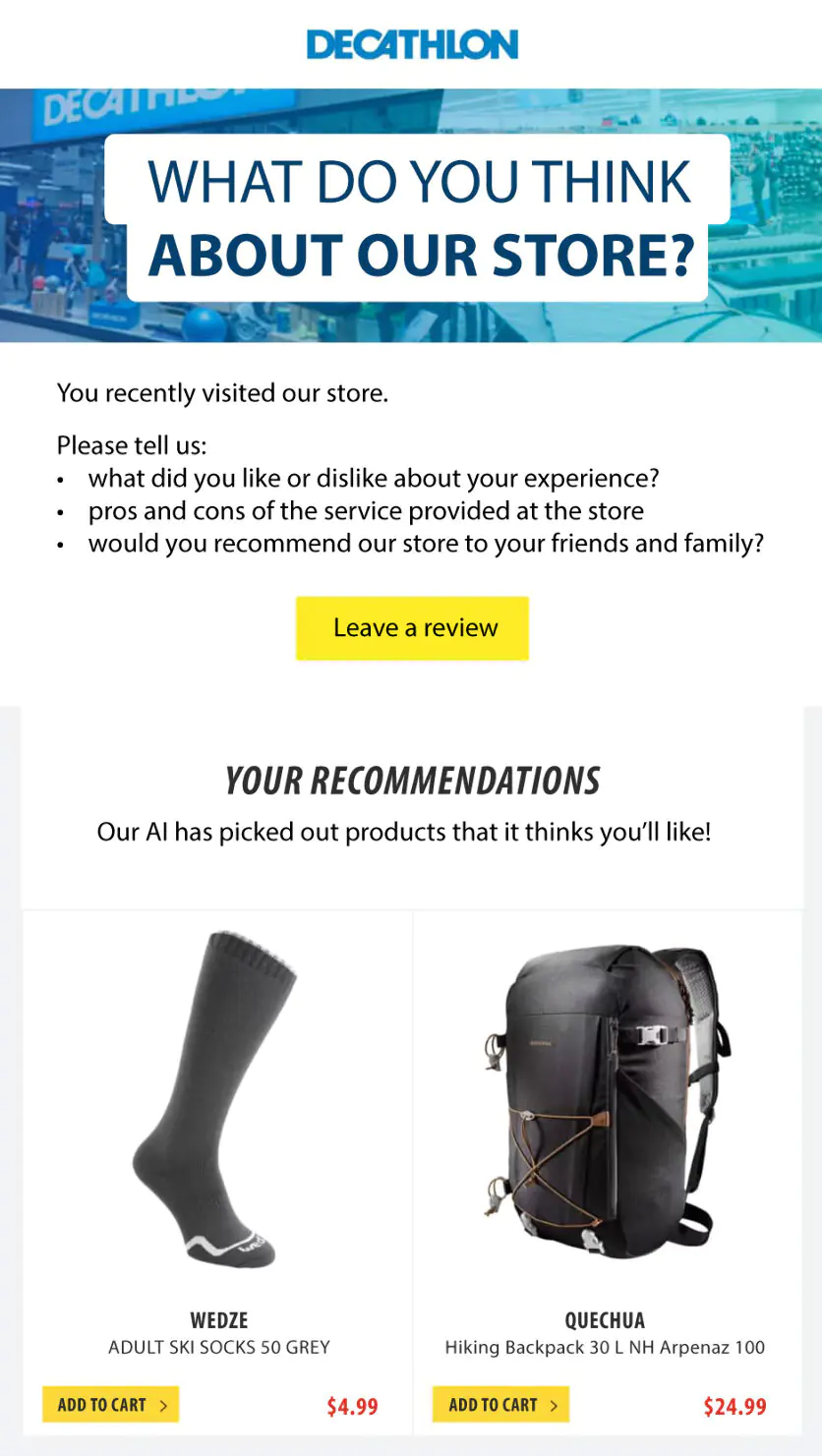
Emails with a request to leave a review regarding the product and the store
Product reviews are moderated and published on the website by call center employees.
A product with a rating below 3.8 has two options:
- if the product is made abroad, we stop purchasing it;
- if the product is made in the CIS, its quality and functionality are improved at the production stage.
This was the case with snow tubes (inflatable sleds). Last winter, customers gave us a lot of negative feedback regarding snow tubes, saying that they were poorly glued, which resulted in them deflating. Throughout the summer, the snow tubes were improved and tested at the factory. This winter, we sent an additional email with a request to evaluate the snow tubes. However, reviews and ratings are still lower than expected. Based on this knowledge, a hypothesis emerged: customers may be misusing the product. For example, if they inflate their tubes in the cold but do not deflate them when they come home. As a result, the expanding air tears the tubes apart. The new hypothesis has yet to be tested.
Store reviews are one of the KPIs in every Decathlon store. The store aggregates its rating based on reviews from email, Google, and other local map services. Every week, all store employees receive an email with this rating and sample reviews. This helps improve the quality of service.
We send out emails to help customers make rational choices
Previously, Decathlon sent out emails after purchases had been made. These were full-fledged guides that helped customers understand what else they could buy to maximize the comfort of their sporting activities. For example, a sequence of three emails about bicycles, in which the first email was the most successful:
1. Email about bicycle accessories
-
Open rate20%
-
Click rate4.7%
-
Conversion rate0.4%
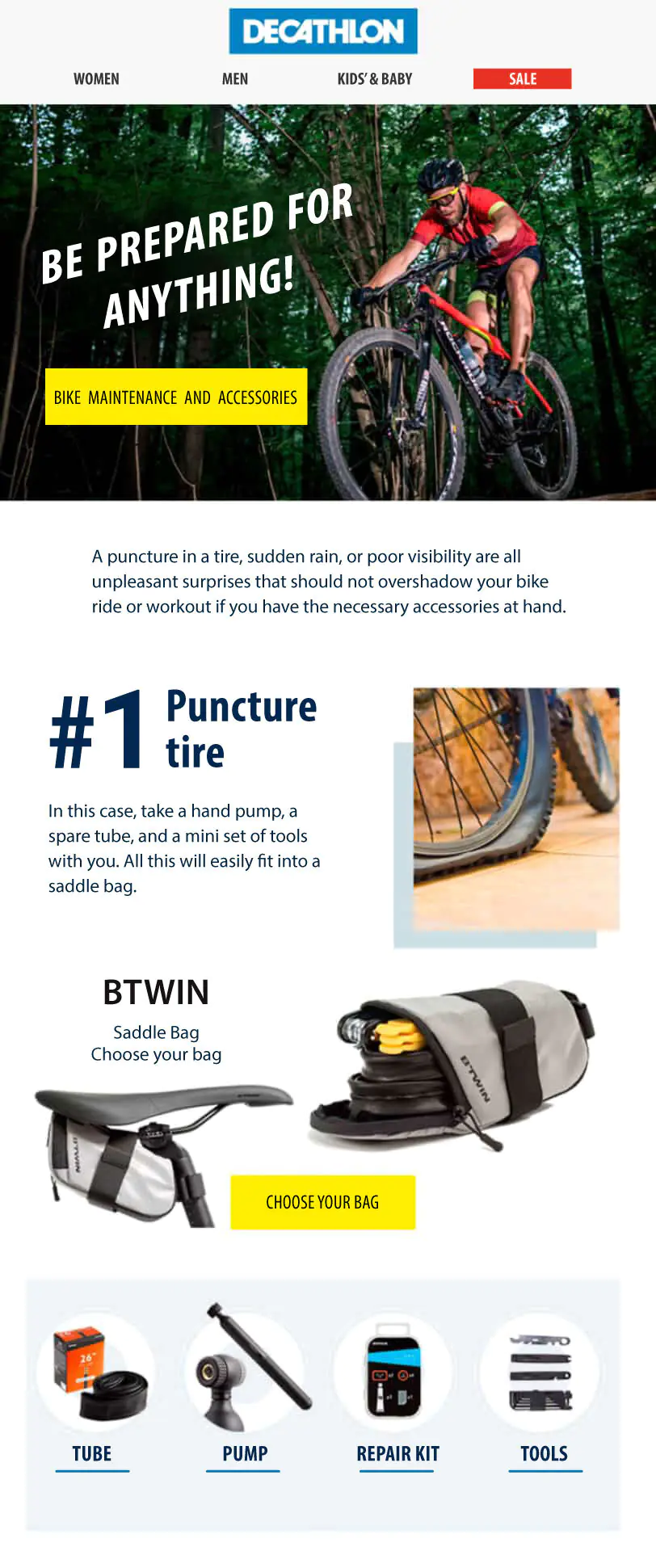
2. Email about bicycle care products
-
Open rate18.1%
-
Click rate2.7%
-
Conversion rate0.2%
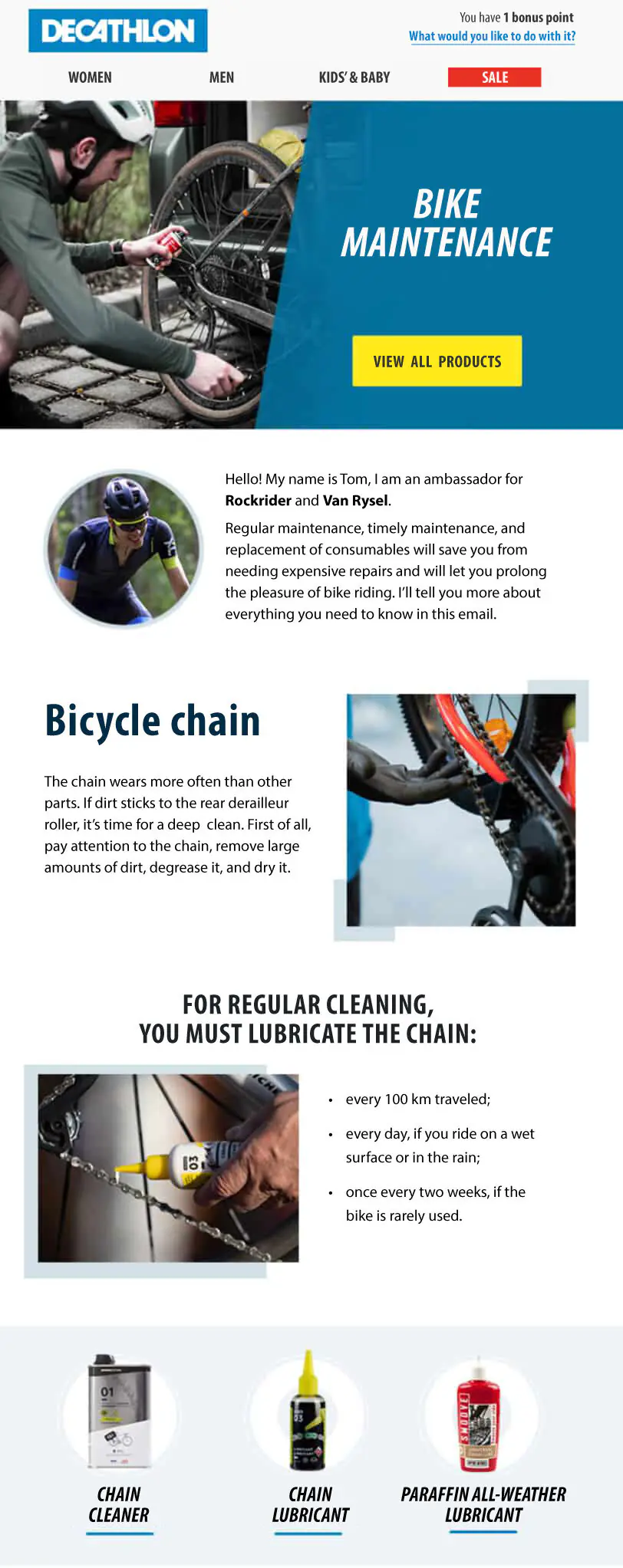
3. Email about accessories (helmet, bike bags, locks)
-
Open rate13.4%
-
Click rateClick rate2.1%
-
Conversion rate0.1%
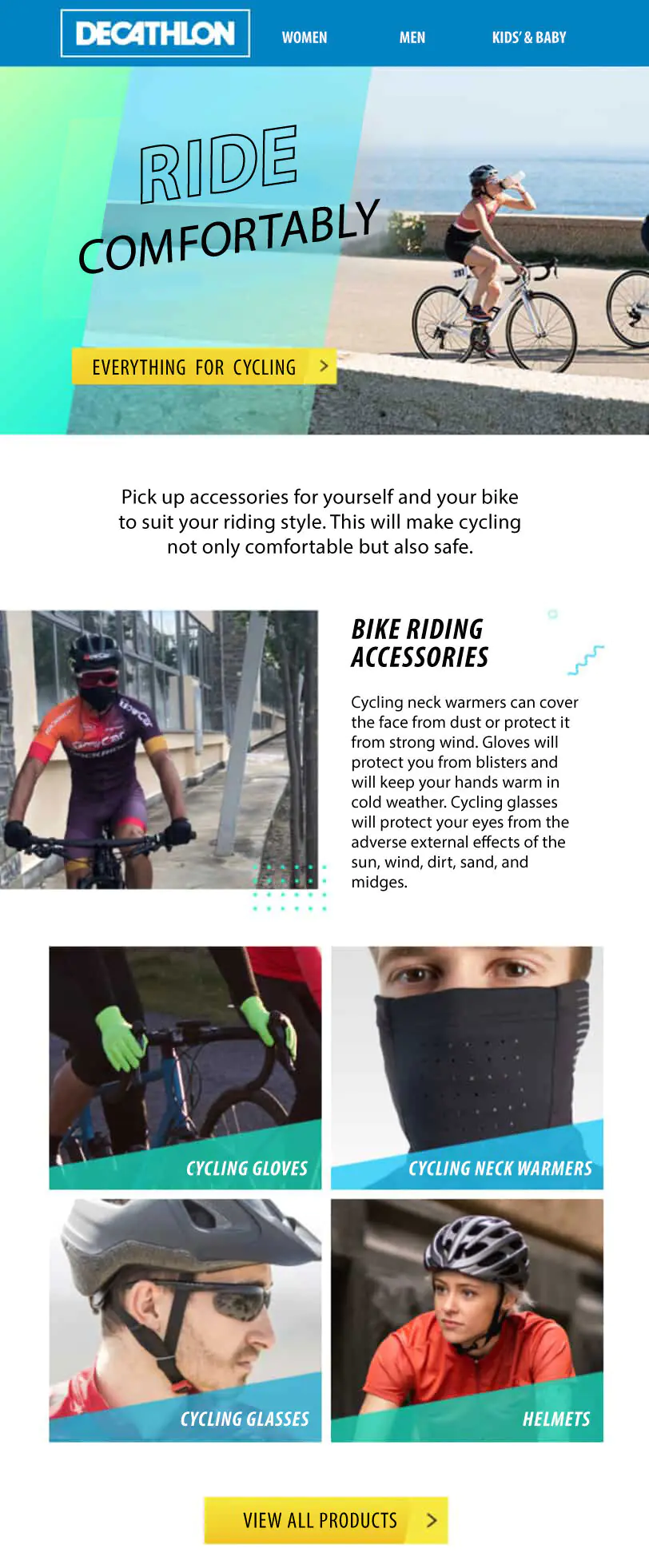
Emails with a request to leave a review regarding the product and the store
Post-purchase emails did not generate as many sales as expected. This was due to the peculiarity of the Decathlon audience — they make few repeat purchases.
So, Decathlon focused on pre-purchase emails instead, such as abandoned category browsing. The emails are created in the form of guides to help customers make rational choices — buying sporting equipment that meets their needs, not just because it’s popular or because there’s a discount. This may also include choosing hunting equipment according to the needs of a real hunter. These kinds of emails are also useful because product cards do not always explain in detail what to pay attention to when making a purchase.
Email about hunting equipment:
-
Open rate35.6%
-
Click rate20.5%
-
Conversion rate0.6%
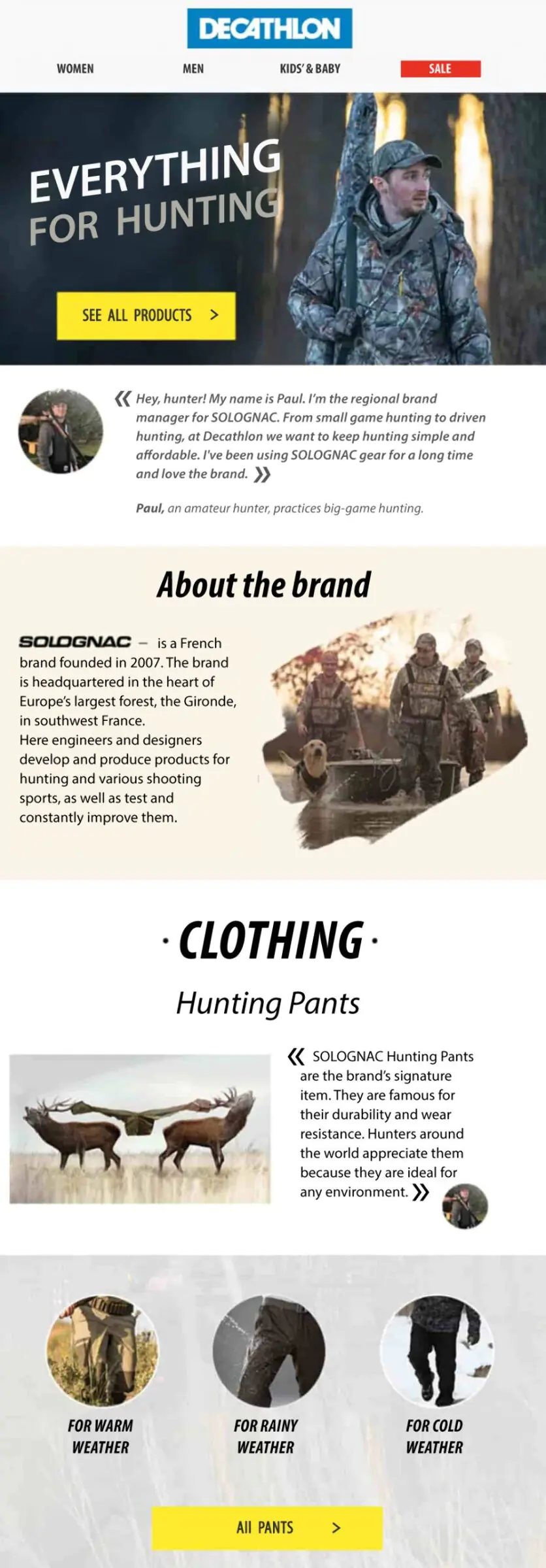
Email about how to choose the right hunting equipment
We selected the sending frequency after running an A/B test, in order to stop spamming customers
We send a lot of emails — these comprise two weekly bulk campaigns and trigger messages. This is a lot for our business. However, if we send one bulk campaign, the revenue generated by the email channel will fall by approximately 50%.
At the same time, in order not to spam customers, we send out bulk emails only twice a week. The first email we send is to the entire audience containing the same special offer. The second is a personalized special offer, which is sent depending on the customer segment.
At the same time, in order not to spam customers, we send out bulk emails only twice a week. The first email we send is to the entire audience containing the same special offer. The second is a personalized special offer, which is sent depending on the customer segment.
Decathlon tested sending two bulk email campaigns on a weekly basis.
Hypothesis. If you send two weekly bulk campaigns, the revenue generated by the email channel will increase.
Conditions:
- We have chosen two audience groups of 100,000 subscribers. The groups share two characteristics — an interest in a particular sport, and that they are made up of active email subscribers who read our emails.
- One group received one weekly email, and the second group received two weekly emails.
Test results (with a 95% reliability level):
- The group that received one email a week had an increased open rate and their unsubscribe rate decreased by 35%.
- The group that received two emails demonstrated lower overall performance scores. However, this group generated more revenue than the first.
This is why we made the decision to send two emails per week to all subscribers.
How we launched a loyalty program and achieved a 44% share of identified customers
Since Maestra integrated with Set Retail POS software on its side, we haven’t had to spend time and resources on this task and were able to focus on integrating the platform with the new online store. (Editor’s note: when we set up the loyalty program for Decathlon, the integration with Set Retail software had only just been configured; it is now available for all companies.)
Our loyalty program is flexible and up-to-date, we don’t have servers or data centers. Everything is based on cloud solutions and is easy to manage — nothing needs to be hosted.
The platform was integrated with cash registers in January — February 2021 and was launched in two stages:
1. From March to September 2021 we tested the loyalty program in five stores. We checked how data transfers function, how customers react to bonuses, and how profitable the program is for business.
During this test, we experienced some minor issues on the side of the POS: there was a risk that data could be incorrectly transmitted to the platform. This happened because we were one of the first companies to activate our loyalty program using Set Retail software. Not everything worked according to plan as both Maestra and Set Retail hadn’t yet figured everything out. We fixed all the problems together and debugged the system. At the same time, there were no serious, irreparable failures.
Simultaneously, from June to August, we integrated a new online store (the loyalty program was not connected to the existing one.)
2. From September to November 2021, we launched a loyalty program in 62 retail stores across the country.
We spent two months training employees and incorporating the retail loyalty program and adding stores to the platform. This went smoothly because Set Retail was already connected to Maestra and only minor adjustments were made.
At the same time, we tested how promotions are triggered and how data is transmitted to the platform from the new online store. Everything is currently ready to go. We are waiting for its launch so that the loyalty program will become omnichannel.
Currently, data on offline and online purchases on the platform is not connected. For example, if a loyalty program participant buys a bike offline and then buys a helmet and gloves in the online store, these would be seen as two different customers for the platform. There is no seamless omnichannel experience just yet.
We have made a simple Net Promoter Score (NPS) among loyalty program participants. The NPS is good. People are happy and ready to scan their cards with every purchase they make.
At the same time, we see that the speed at which the number of participants in the program grows depends not only on interesting products but also on two other factors:
— Location. If there are no other sports shops near Decathlon, customers will visit the store intentionally. This means that we have a good scanning rate (level of customer identification). These are our loyal customers and their visit to our store is intentional. When a store is inside a shopping mall, people make random purchases and do not become members of the loyalty program.
— If cashiers explain the terms of the loyalty program in detail to the customer, the motivation to become a member and use the card increases with each purchase.
— Perhaps the results would have been better if the loyalty program had been made omnichannel from the start. The customer’s interaction experience with the Decathlon program is incomplete, and this could slightly distort the results of the test which was run in five stores.
Our future plans
1. Send transactional emails for orders from Maestra. Emails are currently sent from a self-developed tool used by the European divisions. This has a significant drawback: the transactional email is the same for all types of delivery. Therefore, the wording in the email is pretty ambiguous — we have to use the same subject line for both delivery and in-store pickup, which doesn’t give the customer a clear understanding of whether the goods will be delivered by a courier or whether they need to go to the store to pick up their order.
2. Analyze the entire customer journey through the sales funnel, in order to not attribute a purchase by the last click to the last channel of interaction but instead to take into account all channels and points of contact with the customer. This will allow us to see which channels and to what extent they influence the purchase. For example, a customer saw a great T-shirt in an email, closed it, and two days later visited the Decathlon website via Google and bought the same T-shirt. While the loyalty program is just starting to work at full capacity, the customer journey is hard to follow. However, an analyst has since joined the Decathlon team to tackle this mission.




